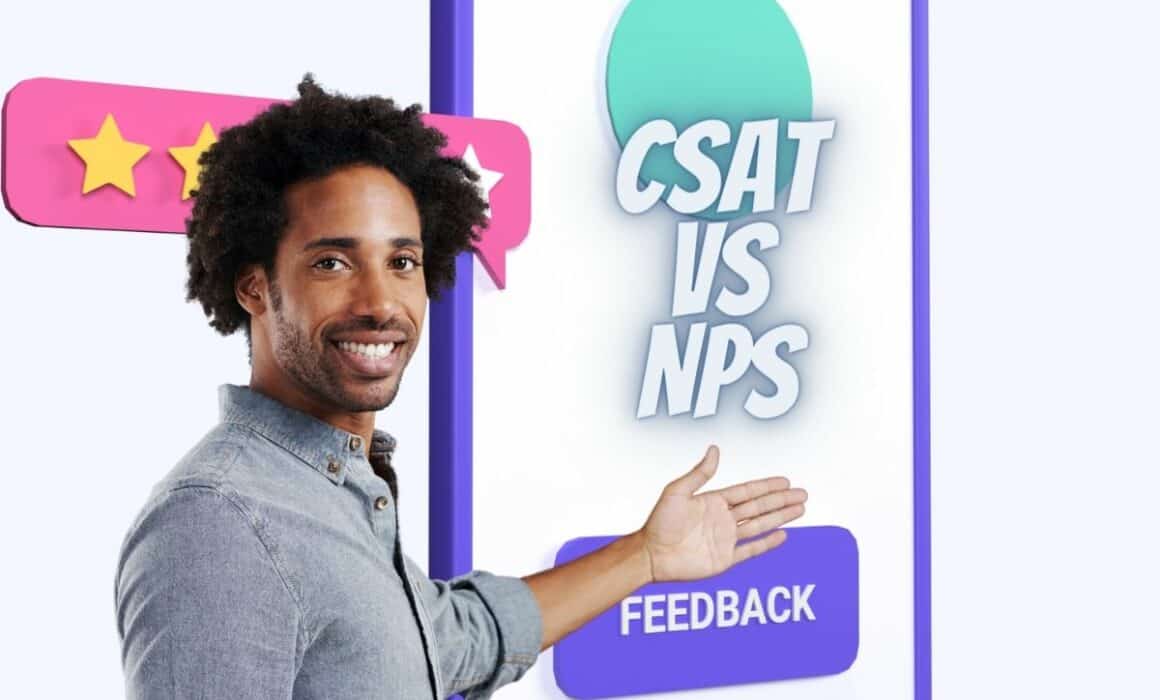CSAT vs NPS: Similarities, Differences, And Best Practices
Product managers understand that keeping the customers satisfied and happy is one of the top priorities in any project. But to achieve this, you must understand customer journey and satisfaction. Otherwise, it’s difficult to determine which direction to go.
This is where the concept of customer experience (CX) metrics comes into play. In essence, these metrics measure or estimate how satisfied customers feel with your offerings.
Among the numerous CX metrics, the two most popular ones are CSAT and NPS—two metrics that carry several similarities but are also incredibly different from one another.
Due to these differences, one will objectively be more suitable for certain projects. Which one is better for you is something you’ll find out in this article. Read on as we discuss the differences between CSAT and NPS and how to leverage them to improve customer and product experience.
Table of Contents
CSAT vs NPS: A brief overview
CSAT and NPS are two metrics designed to measure and analyze a customer’s experience with a product or the company altogether. They are to customer satisfaction as GPA is to a student’s academic achievement. These metrics don’t reflect the entirety of a customer’s experience with your offerings, but they’re, at the very least, an accurate representation of it.
What is CSAT?
CSAT stands for Customer Satisfaction, and it does exactly what the name suggests. More specifically, it measures a customer’s level of satisfaction with a particular product or offering.
Google Play Store, or any other app store, for that matter, is full of CSAT instances. Each review of an application, which often ranges from 1 to 5 stars, is a measurement of the supposed user’s overall satisfaction with the app. We can say the same for reviews of hotels or restaurants.

Source: Google Play
What is NPS?
NPS stands for Net Promoter Score. The keyword here is “Promoter,” as it represents the willingness of a consumer to promote your offerings, or your company itself, to other people.
Perhaps the most iconic question that measures NPS is: “Would you recommend this product/item to a friend – a question you may have already encountered numerous times?”
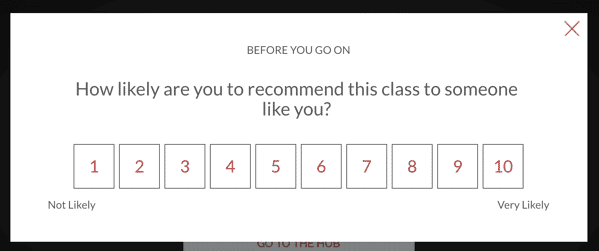
Source: hotjar
CSAT vs. NPS: Key similarities
From their description alone, one can surmise the potential uses of each metric in product management, as well as the characteristics that set the two apart. However, it would be more appropriate to discuss why they’re often compared to each other in the first place.
#1. Both measure an aspect of customer satisfaction
Since they’re both called CX metrics, it makes sense to assume that both CSAT and NPS measure an aspect of customer satisfaction. What aspect of customer satisfaction measurement, however, can vary from case to case.
#2. Both are qualitative metrics
Qualitative metrics are measurements that rely heavily on customer feedback that’s subjective rather than objective. They’re unlike quantitative metrics that track customer satisfaction objectively via formulas using hard data. CSAT and NPS are both qualitative metrics.
They are unlike Customer Churn Rate, an example of a quantitative metric, as it’s an objective measure of business performance based on hard data like customer retention rates.
#3. Both are measured using surveys
You can measure CSAT and NPS through surveys—a common denominator in qualitative metrics. That’s another difference with quantitative metrics like Customer Churn Rate, where you can easily measure or calculate if you have data on customer retention rates.
Of course, let’s not forget about the main similarity between the two—they’re both well-known in the business industry. Many other metrics carry these three similarities with CSAT and NPS, such as Customer Effort Score, but they are not as well-known as these two.
CSAT vs NPS: Key differences
Product managers like to associate CSAT with NPS due to their many similarities. But in reality, the two have more differences than similarities. Let’s take a look at each one.
#1. NPS focuses on the customer, CSAT focuses on the product
The Net Promoter Score tackles the overall loyalty of customers towards the company or its products. A high NPS would indicate that customers are generally loyal to your brand.
The NPS survey may also reveal ways to improve your customers’ loyalty further, be it through a rewards program or discounts. In other words, it focuses on the customers.
Meanwhile, a high CSAT indicates that the product, in its current state, is satisfactory, meaning its features and specifications are just right. In short, it focuses on the product itself.
These two metrics are connected, but a high NPS doesn’t always equate to a high CSAT. Let’s take the example of Apple—an incredibly popular brand that manufactures electronics.
According to Retently, Apple’s NPS in 2016 through 2017 was 72, which, for your reference, is incredibly high. It was then followed by a score of 63 in 2018, which was still relatively high.
This reveals that customers are loyal to Apple. However, that doesn’t necessarily mean the loyal customers were satisfied with all their products. In fact, it was from 2016 to 2019 that the butterfly keyboards were introduced—perhaps one of Apple’s worst design mistakes.
CSAT was not as high, as far as Mac products were concerned, due to this design failure. But it was clear that the low CSAT brought by this error didn’t lead to their NPS taking a large hit.
#2. They have distinct calculations
Though CSAT and NPS use a numerical scale of 0-5 or 0-10 for each survey, the final score is often calculated differently. To measure CSAT, you must conduct the survey and divide the positive responses by the total number of responses. Multiply the quotient by 100, and you get a percentage value that indicates the CSAT score. The standard formula is as follows:
CSAT = (Satisfied Customers/Total Number of Responses) x 100
Let’s look at an example 2022 survey conducted by the ACSI Household Appliance and Electronics Study. The survey consisted of 9,271 customers. In it, Apple’s CSAT score is 82.
Using the formula, you can assume that 7,602 customers were satisfied with Apple’s product.
Now, let’s consider Apple’s 2022 NPS of 72. That doesn’t mean for every 1,000 respondents, 720 are likely to promote Apple. Rather, NPS is the difference between the percentage of people who would promote the brand (Promoters) and the percentage of those who would discourage other people from buying from the brand (Detractors). The formula is as follows.
NPS = (Percentage of Promoters) – (Percentage of Detractors), where
Promoters = Positive Responses/Total Number of Responses
Detractors = Negative Responses/Total Number of Responses
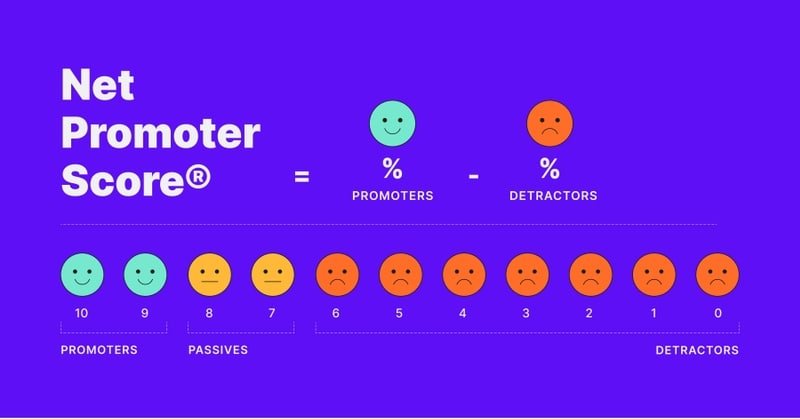
Source: Survicate
That’s why a CSAT score of 50 or below is terrible because more people didn’t like your product than those who did. Meanwhile, an NPS of 50 is good, high, even, because it reveals that there are 50% more promoters than detractors for your product or brand. Furthermore, it would also explain why a CSAT score can only range from 0 to 100, but NPS can range from -100 to 100.
#3. CSAT and NPS have different benchmarks
Benchmarking is when you measure your performance against comparable examples.
With product management, it’s when you compare the performance of one of your products to either your other products and offerings or to a similar product of your competitors.
Naturally, you’d want your CSAT and NPS scores to be higher than the benchmark. However, the benchmark would often vary according to the particular aspect you want to compare.
In the case of CSAT, product managers would usually compare their scores with their competitors. If your competitor has a CSAT score of 81, for example, you would want to take steps to go beyond that score, typically through improving certain product features.
On the other hand, with NPS, you’d compare it with the industry average. You can still consider the competitor’s NPS, but the industry average is the reliable benchmark.
For your reference, there’s usually a new NPS benchmark according to the industry every year.
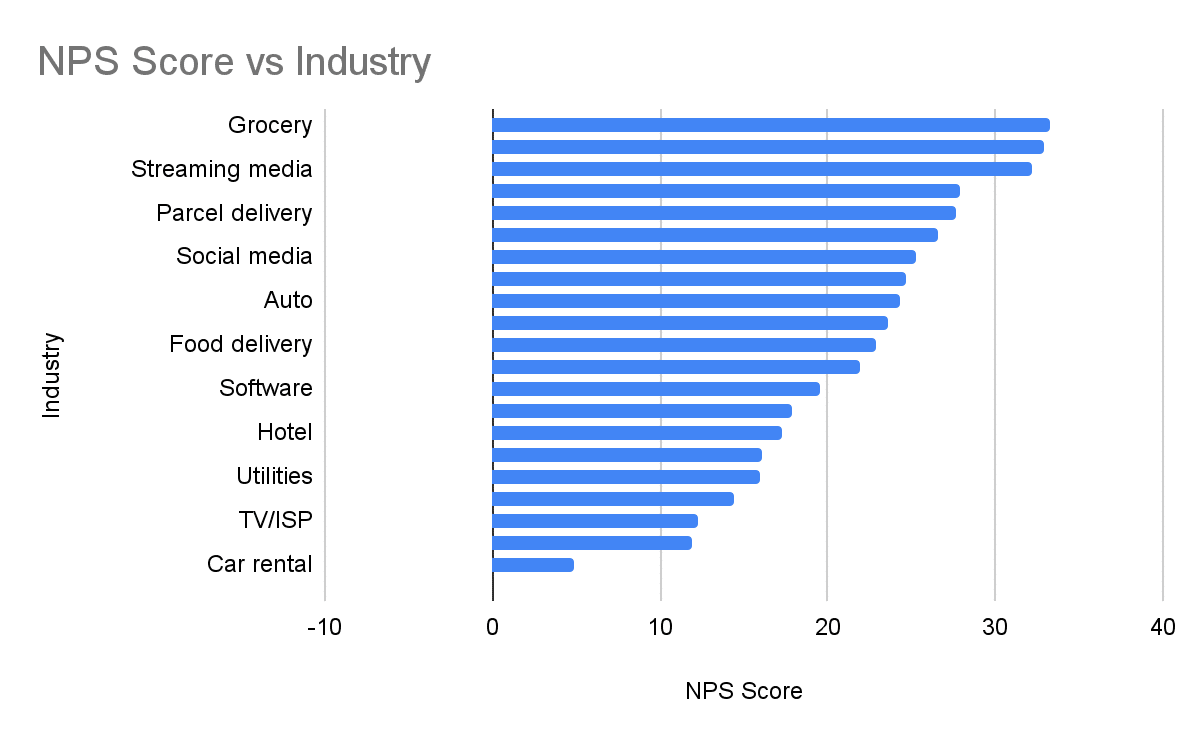
Source: TrustMary
Keep in mind that competitors and industry averages aren’t the only ones that can be the basis for benchmarks. You can also benchmark both NPS and CSAT on your historical performance
#4. NPS is long-term, and CSAT is short-term
Companies typically conduct a number of CSAT surveys every month or year. These surveys focus on a specific interaction or experience between the customer and the brand. It can happen whenever the support staff answers a customer’s query or the customer buys an item.
Meanwhile, NPS is more of a long-term metric or indication of the customer’s perception of the company. Product managers would measure this metric once per quarter or even per year.
#5. They demand different questions
To measure the NPS, product managers would only ask a singular question to customers: How likely are you to recommend our brand to a friend? or something along those lines.
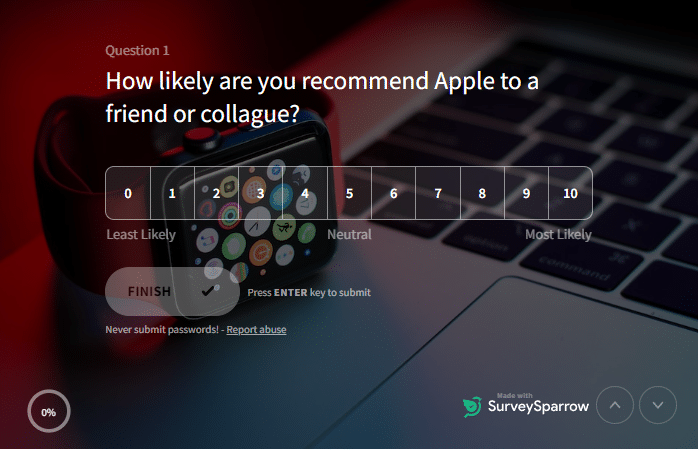
Source: SurveySparrow
With CSAT, there are a variety of questions that a brand can ask, each with a different connotation. Below are some examples and the company that would typically use them:
- Apple: How would you rate the assistance provided by the customer support team?
- Uber: How would you rate your satisfaction with your most recent ride?
- Amazon: How satisfied are you with your recent purchase?
- Airbnb: How would you rate the cleanliness of your lodging?
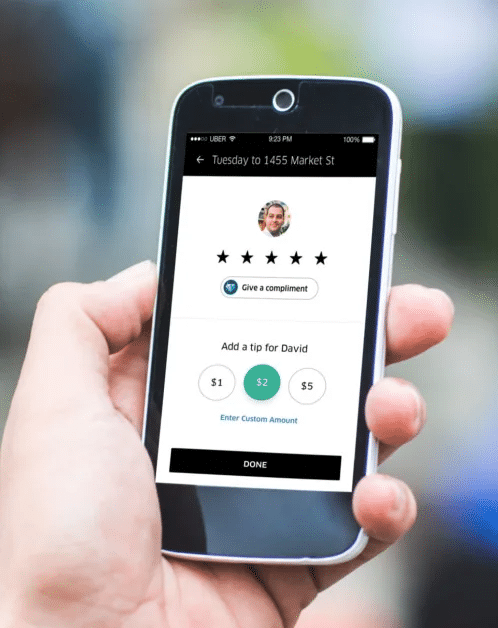
Source: Uber
Unlike with NPS, there’s no standard question to measure CSAT. It ultimately depends on the interaction you want to measure and what aspect of that interaction you intend to analyze.
While they have several differences that make each metric suitable for different scenarios, it’s often advisable to use both in conjunction with the other. Product managers, in particular, analyze NPS for brand loyalty and customer sentiment and CSAT for individual products. Doing so allows you to get the best of both worlds since they really don’t have much overlap.
Why might one choose CSAT over NPS?
CSAT offers a variety of advantages over NPS, so it makes sense that a product manager would focus on this specific metric. Here are some examples of these advantages:
- Immediate results: A CSAT survey can provide immediate and actionable customer feedback regarding their satisfaction. This allows product managers to address issues quickly to improve customer experience without waiting for the quarterly report.
- Flexibility in questions: As stated earlier, product managers can come up with different questions depending on their objectives. If you want to analyze your customer support, you can craft a question that tackles that aspect. NPS offers no such flexibility.

Source: Hotjar
Hotels and restaurants are the perfect examples of companies that would benefit more from CSAT than NPS. These kinds of businesses can make immediate changes to their offerings, unlike companies such as Apple, for example. So, immediate feedback is more valuable.
Why might one choose NPS over CSAT?
Likewise, NPS offers several advantages that aren’t present with CSAT surveys. These include:
- Spotting trends: NPS measures loyalty over long periods. Whenever loyalty increases or decreases, NPS can be valuable in determining what led to that change. In doing so, product managers can quickly determine what to avoid and continue.
- Simplicity: Surveys are almost always optional. It’s not mandatory for customers to answer them, so an overly complex survey will likely sour a customer’s mood. NPS offers simplicity, making it easier for customers to understand and answer the survey.
An example of companies that benefit more from NPS is subscription-based companies. That’s because they rely heavily on customer loyalty, which is the basis of their offering.
Best practices for measuring CSAT and NPS
CSAT and NPS might be powerful tools for product managers, but they’re only as valuable as those leveraging them. Below are some tips to get the most out of these CX metrics.
#1. Utilize multiple channels
Not all customers have access to multiple communication channels. If you only use emails to conduct surveys, for example, you won’t get data from those who only use social media.
Likewise, if you only use social media for surveys, those who only use emails will be left out.
For that reason, consider utilizing multiple channels when conducting surveys. Doing so can increase your response rates and make the feedback more diverse.
#2. Consider the timing of your surveys
While it’s true that having more data would make your analysis of CSAT and NPS more accurate, it’s not advisable to conduct surveys as frequently as possible. Doing so can lead to survey fatigue, a phenomenon where your customers would lack the motivation to participate.
Similarly, you wouldn’t want to conduct customer satisfaction surveys too rarely. Otherwise, you may be unable to collect enough data to make informed decisions toward improving customer experience.
#3. Keep the survey simple and short
As mentioned earlier, the mood of customers can sour if the survey is too long or too much of a hassle to understand. This usually isn’t an issue with NPS surveys, but if you’re conducting CSAT surveys, you will benefit from making them as simple and short as possible.

Source: Customer Thermometer
#4. Categorize data according to customer segments
No matter the brand, the customer base would typically have several categories. Apple, for instance, may have the following customer segments:
- iPhone users
- Mac users
- iPad users
- Creative professionals
- High-income users
By separating the NPS and CSAT scores into different categories, you can gather more targeted insights. You also gain a better understanding of customer needs depending on their persona.
#5. Make use of software for real-time analysis
While it’s admirable for product managers to analyze NPS and CSAT scores manually, you must understand that human error is inevitable. To minimize its possibility, it can go a long way to use specialized software. Not only does it offer more accurate analysis, but it’s also usually a lot quicker.
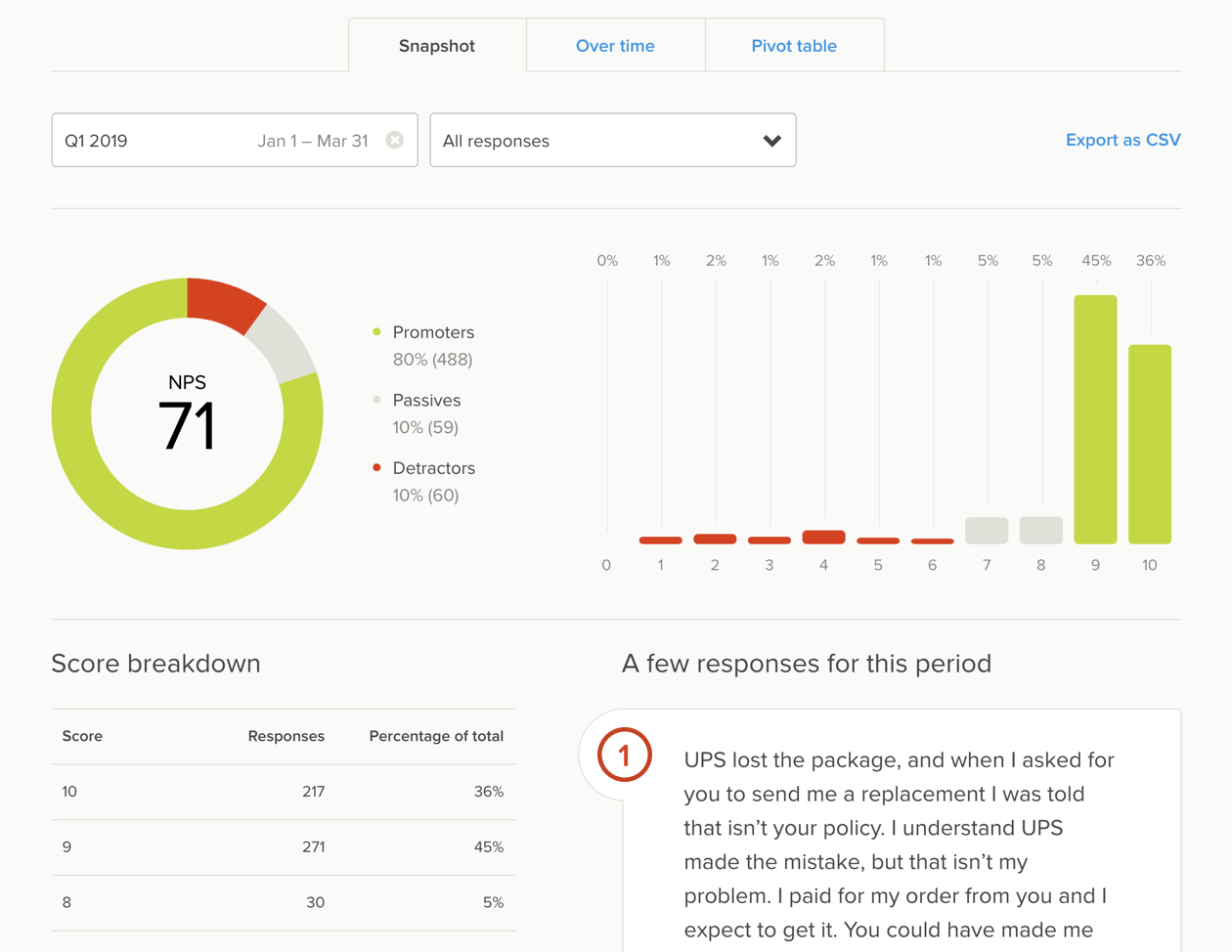
Source: Delighted
The bottom line: choosing the right metric for your product’s success
You don’t necessarily need to stick to only one customer experience metric. If you have the necessary resources, it won’t hurt to measure and analyze more than one customer satisfaction metric—it’s advisable, even. Regardless, an understanding of the differences between CSAT and NPS is still necessary if you intend to boost these metrics and leverage them for future products.
Interestingly, gamified experiences and personal offers are one of the most effective ways of building stronger connections with customers. Request a demo now and learn how gamification can keep your customers engaged and maximize NPS, CSAT, and other customer-oriented metrics.
[et_bloom_inline optin_id=”optin_3″]
Download your free
“Gamification Guide”
Get your PDF now and start transforming your approach to digital engagement!
Latest Posts
Machine Learning In Finance: 12 Essential Applications
The impact of machine learning on finance is significant. Thanks to this technology, financial institutions are now equipped to make efficient decisions. Through the analysis of data sets, machine learning […]
How To Create Interactive Compliance Training For Bank Employees
Banking compliance training isn’t just another task. It’s the stage where everything else performs. Banks must navigate a myriad of regulations and laws. After all, this is a trust-driven, high-stakes […]
How Fintech Apps Are Using Gamification To Increase User Engagement
Discover how gamification in fintech is revolutionizing financial engagement, making banking fun & boosting user loyalty.
